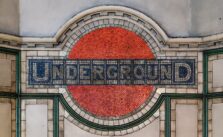Photograph Source: Jonas Magnus Lystad – CC BY-SA 4.0
With a brand new major London tourist attraction opening soon in a network of World War Two tunnels, and with the second American revolution banging on in the background, I’ve been thinking about cultural undergrounds. Here invisible insurrectionists have long embraced not just London but Ireland, Russia, cross-channel Europe, the Americas, Africa. Only weeks ago an underground Sudanese group burst into action outside Chatham House where even a frog had its head bitten off. Even the 1820 Cato Street Conspiracy met on nearby Edgware Road. Soho was often the traditional nurturer of scenes underground.
There I used to watch the odd tribal elder do his or her thing in gifted watering holes like The Colony Room, The French House, Gerry’s. I recall one well known deputy editor rhapsodising about Marx living in the ‘hood while writing Das Kapital. (The deputy editor wrote a book about the German-born philosopher in the end.) If it was poetry we wanted, we had anthologists and poets Michael Horowitz and Eddie Linden wandering through. If it was companionship, or just information, or sheer ribaldry, hey, we had everybody. I remember late Fleetwood Mac guitarist Danny Kirwan at Norman Balon’s Coach and Horses claiming fame overrated. (I didn’t know who he was at the time.) At Blacks, Soft Machine legend Mike Ratledge, courteous to a fault, liked to riff on philosophy rather than his own exceptional psychedelic avant garde jazz-rock. But was it any longer underground?
In the 1950s Colin MacInnes wrote Absolute Beginners during the Notting Hill Riots, importantly romanticising the underground as a free and fair place in the process. Long before I visited London from Scotland, American legend Joe Boyd with Cambridge physicist Hoppy Hopkins had founded the underground psychedelic UFO Club where Pink Floyd (with Syd Barrett) played some of their early gigs. Anarchists, I am told, favoured the Arts Lab in Notting Hill, founded by another American—also via Edinburgh—Jim Haynes. The Mountain Grill famously hosted speed parties with Hawkwind and Lemmy. Future archbishops of Canterbury (Rowan Williams, certainly) listened to the Incredible String Band. Underground press publications International Times (IT) and Oz Magazine were already blowing what remained of mainstream narratives out of the water, its visuals alone by graphic artists Martin Sharp and Nigel Weymouth-English beyond illuminating. Years later, Felix Dennis, former editor of Oz, could still be seen, beard and all, in the half-light of Gerry’s. Perhaps these people are ghosts now who meet in Soho every Thursday night or so. Then came Punk—SEX (Malcolm McLaren and Vivienne Westwood), The Roxy Club (The Clash, The Damned), Centro Iberico and nearby Meanwhile Gardens (Anarcho-Punk).
Next clamoured Post-Punk and Industrial—DIY cultures championed by Industrial Records and still thriving Mute Records. This was followed by those later adherents to psychedics Acid House and Rave culture, plus the squatted Cooltan Arts in Brixton and RampART in Whitechapel—full of experimental art, music, political activism, though never like a WW2 Polish underground resistance. (I knew a squatter extraordinaire at the time who became a brilliant Cambridge professor.) I never saw the Temporary Autonomous Art movement (TAA) in the capital with its lauded underground exhibitions in abandoned buildings, but I knew of the Okupa movement and the anarchists of the 121 Centre in Brixton. Not forgetting what later became Grime and Urban Underground.
Some people today think of their phones as the new underground. Well, that won’t last if the government has its way and gets Apple to hand over access to everyone’s encrypted cloud data on iPhones or iPads: ‘An unprecedented attack on privacy rights that has no place in any democracy,’ warns Rebecca Vincent of Big Brother Watch. Mind you, most people here don’t even know about the possibility of the Bank of England underground vaults being depleted of gold. At the end of the day, however, we should still have the incredible Windmill in Brixton and pop-up venues like Paper Dress Vintage in Hackney for underground fashion and music to conjoin. There is still from all accounts Electrowerkz in its late 19th century warehouse near Angel; the avant garde Corsica Studios in Elephant and Castle; marathon nights at FOLD between Canning Town and Bow. But—if dissenting voices really do define an underground scene—there may be trouble ahead with so-called rightist nights.
As background, the night before Trump’s inauguration in Washington DC was the Coronation Ball. Footing most of the bill for this was Remilia Corporation, a conceptual art movement. (Remilia’s NFT collection—called Milady—is worth over $150 million alone, though Max Keiser, advisor now to El Salvador’s bitcoin-savvy president Nayib Bukele, did once tell me while discussing the artist that NFTs were a scam.) Milady, I am also told, has a meme famously posted by Elon Musk. Reportedly central to Remilia is right-wing UK writer Nick Land who reckons the world moving so fast that reality has become unhinged. (Talking of which, Remilia was founded in 2021 by pseudonymous Charlotte Fang, a man.) Enter this hazardous world and it seems likely we will be entering a kind of deliberately contentious mind-warp on top of which our age-old concept of the underground will be turned upside down. (So it becomes overground?) Significantly, Remilia’s Milady even had a rightist Rave—right here in London—in Walthamstow. ‘Remilia has an energy which matches Trump’s—and promises more disruption to come,’ recently wrote Alexander Raubo in an increasingly right-wing Spectator—what isn’t increasingly right-wing these days?—now owned by Reform UK’s biggest donor Paul Marshall. (Curiously, former Tory cabinet minister, now Spectator editor, Michael Gove, without revealing his sauce or sources, recently joked that Trump sounded like he was on MDMA.)
Thank goodness still for older hippies, however, regardless of their poison. Not so long ago I encountered a senior freak by the Thames in a flashback pad with trinkets and beads and long hair and joss sticks. A real throwback, he reminded me of WW2 Japanese soldier Hiroo Onoda who lived in the jungle until 1974 and still refused to surrender until relieved of his duties by his commanding officer. River Man was like a grand almoner with only his stories to distribute. (‘Gonna see the river man / Gonna tell him all I can,’ sang Nick Drake in the earlier mentioned Joe Boyd-produced album Five Leaves Left recorded in London.) Occasionally, in between underground this and underground that, a serious insight was revealed by River Man: ‘The mind that perceives the limitation is the limitation,’ he said at one point—I had to write it down—quoting Buddha.
The actual underground, the real subways of Europe, have of course always enjoyed links to subversive activity. Most famous were the sewers of Paris with their hotbeds of criminals and revolutionaries—a transgressive space if ever there was one. Conversely, a place like Soho today offers fetching tea towels now of its past. But I do hear the French House on Dean Street is still conversationally strong, and I am glad to hear Trisha’s on Greek Street is in good trim. Trisha, like French House saviour Lesley Lewis, is a true legend (as well as top of the league right now with her beloved Liverpool football team).
No, London’s underground scenes, like its underworld scenes, have always thrived on rebellion, creativity, and self-organisation, constantly shifting, always darting, in response to gentrification, de-gentrification, weaknesses, ugly politics, or beautiful nights. As we speak, another movement will no doubt be being hatched. Even if the rest of the world burns, London’s creative scenes—motored by the fabulous young—will be up to the mark, even on fire itself. Let’s just hope it’s not entirely usurped by rightists. Otherwise the London underground could become busy as hell.

